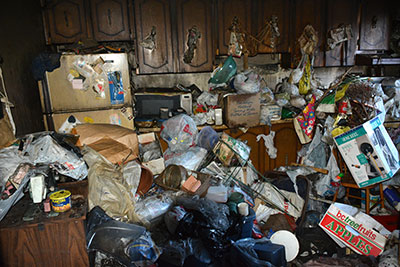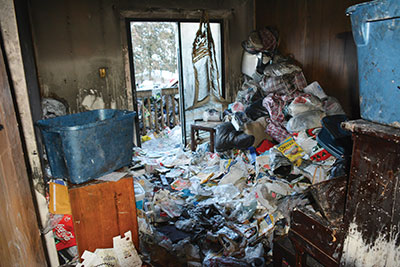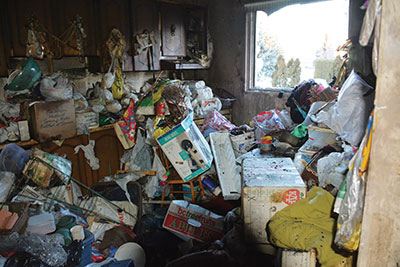
Inside hoarding conditions
By Ryan Pennington
Features Structural TrainingThe No. 1 priority of the fire service is the protection of life. This priority does not change when responders are dealing with the conditions caused by compulsive hoarding disorder.
The No. 1 priority of the fire service is the protection of life. This priority does not change when responders are dealing with the conditions caused by compulsive hoarding disorder. The accumulation of belongings inside the homes of people who can not discard things can become life threatening for the occupants and for firefighters. While hoarding conditions can increase the risk for the entering firefighters, a hoarding situation does not necessarily prohibit a rescue. It is, however, important that firefighters be educated about the tactical changes required in order to safely reach trapped occupants when hoarding conditions exist.
Firefighters who discover hoarding conditions on arrival at a structure fire with a trapped occupant often assume it is not safe to enter the building. Opting not to go in may be a solid decision but it should not be an automatic decision. In the past six months in North America, there have been many instances in which firefighters have successfully searched hoarding environments and removed occupants.
Firefighters in East Vancouver recently experienced a hoarding situation. On Oct. 4, firefighters arrived at a structure fire. An occupant who had been trapped had shattered a back window and was found on the balcony. The occupant had tried to put out the fire with water buckets. The home had no working smoke detectors. Vancouver Fire and Rescue Services told news outlets that the occupant was very lucky to have survived the fire. Although this case didn’t require an interior search, it illustrates the potential for live, trapped occupants. In this case, neighbours heard the occupant screaming from inside the home and called 911.
Adding hoarding conditions to an already dangerous task can be lethal if operational adjustments are not made. Let’s review how searching inside hoarding conditions can be done as safely as possible.
Identify locations of trapped victims
Many firefighters still believe that a search should be performed at all fires – that dwellings are not proven unoccupied until firefighters complete a search. Searching for life is important but using sound decision-making skills should trump the we-always-search mindset. Using size-up skills, firefighters should assess the risks versus rewards to weigh options and determine the potential for live victims who need to be rescued.
This risk-versus-reward process may include not sending firefighters into a burning building if the fire conditions are deteriorating, smoke conditions are not survivable, or the risk of collapse is too great.
The first step in this assessment is to determine the potential for trapped victims. There is a huge difference between suspecting there are trapped occupants and knowing that someone is inside. Making this determination in hoarding conditions can prove to be challenging because hoarders tend to be reclusive and often don’t interact with their families, neighbors or friends, so it can be difficult to assess whether someone is inside. Hoarders often feel ashamed of their situations and refuse to let anyone enter their homes, including family members. Firefighters must use available, on-scene resources to quickly determine if there are people inside.
These actions will aid in the decision-making process:
- Talk to neighbours
- Identify the number of cars in driveway (that are drivable and not filled with belongings)
- Have someone phone relatives (if neighbours have contact information)
- Determine whether 911 calls were made from inside the home
- Determine whether there were reports of screaming or yelling from inside the home
- Determine whether bystanders saw the occupant(s) at or near exits
- Have a pre-fire plan for known hoarder homes
Once the determination has been made that someone is trapped, the next step is to determine the location of the occupant. This task can be difficult in hoarding conditions because as space becomes filled with belongings, the normal living areas may no longer be used for their intended purposes. For example, occupants may not sleep in the bedroom or watch TV in the family room. Commonly, kitchens and bathrooms are the last two rooms in the home to become filled with belongings. Keeping this in mind can help rescuers determine where the occupant might be; these rooms are often the last points of refuge for hoarders and the only means of protection or escape from an advancing fire.
Using the last-known location of the victim can help to determine the point of entry for firefighters to begin their search. The best resource for this assessment is the pre-fire plan for the home, which should have been developed if social, housing or fire authorities were aware of the hoarding situation before the fire. If first responders discover hoarding conditions during medical calls or fire-prevention activities, protocols for establishing a pre-plan should be followed and an assessment of non-filled or less-cluttered rooms with entry and exit points should be included; these rooms should be searched first.
Determine if a search is possible
Once it has been determined that there may be people inside, the incident commander needs to decide if a search is possible. The
biggest variable in this decision is fire conditions: fire volume, smoke conditions, and available resources come into play. The location of the fire and the likely avenues of fire spread should be established, and entry points and available means of secondary egress should be considered.
The risk-versus-reward assessment to commit firefighters to a search should include consideration of:
- Fire conditions
- Smoke conditions
- Blocked entrances
- Cluttered windows
- Weather (wind)
- On-scene resources
Assigning the resources you have on the first alarm can be a complicated process. If the clutter is apparent and the fire is growing, the best course of action may be to knock down of the fire before committing firefighters to the interior. Attack the fire as near the seat as possible; this can help to hold the fire and allow the next available firefighters to enter and make the rescue.
One thing that those of us who study hoarding are not clear about is the effect of the stacks of belongings during a fire. Without scientific studies to prove otherwise, it seems as if the volume of belongings in hoarding conditions limits airflow, absorbs more heat, and provides areas in which occupants and firefighters can be shielded from the affects of fires. In live burn tests conducted with my team of instructors, we found floor temperatures of 65 C (150 F), which is lower than normal, and ceiling temperatures of 200 C (400 F) and higher, which is normal. We plan to do additional tests to confirm our preliminary findings and our belief that stacks of belongings provide a shield effect that may keep occupants alive longer in hoarding conditions. Firefighters need to be aware of this shielding affect when entering a heavy-content environment and should constantly scan the area with a thermal imaging camera and/or adopt a heads-up approach that uses all senses to determine if conditions are deteriorating.
Types of searches
Once the search decision has been made, the incident commander must determine what type of search will be performed. In a hoarding environment it makes sense to use a combination of one or more of these standardized types of searches:
- Wall search
- Oriented search
- Vent-enter-isolate search
- Search rope
- TIC-directed search
Firefighters who enter and do a standard wall search in hoarding conditions could find themselves in the middle of a room with no idea as to their orientation. In heavy smoke conditions, a stack of belongings can appear to be an interior wall.
Use of a thermal imaging camera should be automatic for any team of firefighters searching in hoarding conditions. While this tool is powerful, it should not be relied on alone. TICs can fail and if the smoke conditions thicken to a point at which you cannot see the screen you will need to be oriented in order to escape.
It can actually be easier to find people in hoarding conditions because in many cases rooms have been narrowed down to pathways that lead firefighters straight to the occupants, but the narrow paths can make removal more challenging. Combining a search rope with a TIC and keeping firefighters oriented inside the room is the best way to ensure the searching firefighters remain oriented.
Victim removal
The first priority after locating the occupant is to check each firefighter’s air supply and announce to the IC the location of the patient and identify the lowest air supply.
“Search team one to command, we have located the victim and our air supply is 1500.” Using this information, the IC will determine whether to pull the firefighters out or continue with the removal.
If the decision is made to proceed with the removal of the occupant, the best route of extrication should be determined. Often in hoarding conditions the escape route is the pathway used to locate the occupant. While firefighters are searching inside, outside firefighters should search for secondary routes of removal and remain in constant contact with the searching crew to ensure the best route of removal is found and used.
Once the exit route has been established, communication among rescuing firefighters is crucial. “Ready lift” or “Ready drag” are the only commands that should be spoken when removing patients. Simplifying or eliminating verbal commands should happen before the rescue, within the safety of the fire station. These commands and movements should be practised monthly; add some simple variables, such as up and overs, and narrow pathways. You will be surprised how much communication improves with just some simple adjustments during the drill.
Entering a home that is filled with the belongings of a compulsive hoarder can be a challenge and will push firefighters to their absolute limits. Great air consumption, more physical stress and multiple other dangers can increase the risks that firefighters face when rescuing an occupant inside hoarding conditions. Using sound firefighting skills and best practices will give firefighters the best chance to make the rescue and to come home safely.
Practise making risk-versus-reward decisions with heavy content conditions present and study the needed adjustments.
Ryan Pennington is a firefighter/paramedic for the Charleston Fire Department in Charleston, W.Va. He is assigned to Station 8 and is part of the West Virginia Task Force 1 USAR team. Ryan has more than 15 years of combined fire, rescue and EMS experience. He started with a local volunteer department and continued through EMS to spend five years as a critical care paramedic. Ryan transferred to the career fire service in 2003 and has worked for the City of Charleston since 2007. He is currently a WV State Instructor 2, a hazmat technician, and a certified Fire Officer 2. He is very involved teaching EMS and firefighter safety across North America.
Print this page


